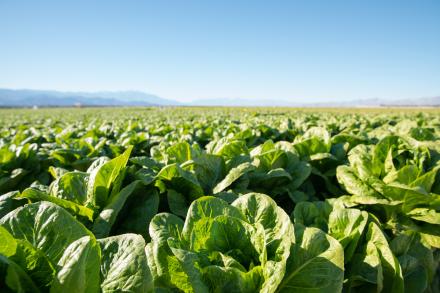Beyond the Salad Bowl
The presence of pathogenic E. coli in lettuce poses a significant concern for the produce industry in the United States. One particular strain, E. coli O157:H7 (EcO157), has been associated with outbreaks of foodborne illness linked to lettuce consumption. With the industry valued at over $4 billion annually, the ramifications of such outbreaks extend beyond public health concerns, to economic impact on the produce industry and erosion of consumer confidence.
Now, ARS researchers and their collaborators have developed a weather-based model that could help predict the contamination levels of EcO157 and other pathogens on lettuce.

A field of healthy lettuce plants grows under sunny skies.
“Outbreaks of foodborne illness due to EcO157 associated with lettuce grown on the Californian Central Coast and Imperial Valley show a seasonality of occurrence,” says Maria Brandl, ARS research microbiologist with the Produce Safety and Microbiology Research Unit in Albany, CA. “The seasonality of lettuce-associated outbreaks indicates a need for proactive measures based on weather parameters.”
The contamination of lettuce with foodborne pathogens can be attributed to factors that include environmental contamination and agricultural practices. Brandl, who is a key researcher in developing the predictive model for EcO157 contamination in lettuce, emphasizes the importance of understanding pathogen survival mechanisms.
“Environmental conditions such as temperature, relative humidity, and solar radiation are critical factors in predicting pathogen behavior on lettuce and other plants,” Brandl states. “These play a crucial role in determining the likelihood of bacterial survival, decline, or proliferation on lettuce, highlighting the complex interplay between environmental conditions in the field and probability of microbial contamination at the time of harvest.”
Researcher Daniel Munther, a mathematical modeler in biology at Cleveland State University who collaborates with Brandl on the model project, underscores the need for robust risk assessment tools to mitigate contamination, stating, "Our model illustrates the correlation of weather conditions with the risk that foodborne pathogens survive, decline, or multiply after contaminating a plant.”
This model, leveraging readily available weather data from weather stations, offers a promising solution to preemptively address pathogen-related risks in lettuce production. Moreover, Munther notes, “the model is simple and user-friendly, with minimal input requirements, and may be applicable to diverse leafy greens-growing regions in the U.S. because it is based on weather data.”
Regulatory agencies, poised to leverage the model's predictive capabilities, stand to benefit significantly in assisting the industry with a simple tool to enhance the microbial safety of leafy greens.
Looking ahead, Brandl and Munther plan to refine and expand the model. The weather input data in the current model are solar radiation, temperature, and relative humidity, with the latter two parameters used to predict dew formation on the leaves.
“The presence of water on plants is crucial in determining what bacteria do on plant surfaces,” Brandl states. “We would like to integrate a leaf wetness factor in the model that includes not solely dew formation, but also water presence on the leaves from rain and irrigation, and overall leaf wetness duration. Additionally, plant age may be a key factor.”
These advancements would further enhance the predictive accuracy of the model. While the model presents a promising avenue for proactive risk management, researchers acknowledge the need for further refinement before its seamless integration into existing frameworks. Challenges remain in implementing the model on a broader scale, but the scientists envision a future where it evolves into an application interfacing with weather stations, thereby facilitating widespread adoption. — By Katharina Hirschi, ARS’s Office of Communications

